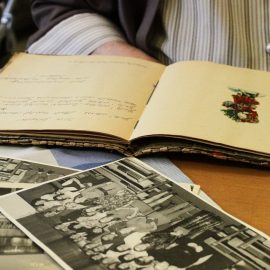

This article is an excerpt from the Shortform book guide to "The Diary of a Young Girl" by Anne Frank. Shortform has the world's best summaries and analyses of books you should be reading.
Like this article? Sign up for a free trial here .
What is the story of Anne Frank? How did her life change when the Nazis occupied Holland in 1940?
In The Diary of a Young Girl, Anne Frank tells the story of her life in the Annex, an attic apartment where she was hiding with her family during the Nazi occupation of the Netherlands. The diary was preserved by Anne’s friend, Miep Gies, and shared for publication by her father after the war.
Here is a brief overview of Anne Frank’s story.
What Is the Story of Anne Frank?
Anne Frank’s story has become famous thanks to her father Otto Frank. It was him who compiled her diary entries and published them as a book. As it was never truly written with the intention of publication (Anne was simply keeping a personal diary), she doesn’t develop any of the themes in an intentional way. The power of the narrative comes through the context of WWII and the horrors of Jewish persecution and genocide.
Life Before Hiding
Anne was the daughter of Otto and Edith Frank and had a 15-year old sister named Margot. Anne was born in 1929 and lived in Frankfurt, Germany until she was four. As anti-Semitism grew in Germany, the Franks moved to Holland to escape persecution.
In 1940, the Germans invaded the Netherlands and implemented strict anti-Jewish restrictions:
- Jews must wear a yellow star at all times.
- Jews can’t be on the streets between 8 PM and 6 AM.
- Jews can’t go to theaters or any other form of entertainment.
- Jews can’t use bicycles, cars, or streetcars.
- Jews can only go shopping between 3-5 PM.
- Jews can’t take part in public athletic activities.
- Jews can’t visit Christians in their homes.
Despite these overwhelming restrictions, Anne lived a relatively normal life before hiding. She went to school and had friends. In her diary, she talks about her ever-changing relationships with her classmates and the youthful frustrations of an average 13-year old girl. These frustrations included deciding who her best friend was and figuring out which boys liked her. Her restrictions impeded her at times (she couldn’t go to the movies with her friends and had to walk everywhere), but she kept her focus on her schoolwork and classmates.
A few days after receiving her final marks, Anne’s life turned upside down. Her sister, Margot, told her that their father had received a call-up from the SS, a Nazi paramilitary force. Receiving a call-up almost always meant being sent to a concentration camp. Margot told Anne that they were figuring out if they could move into a hiding space they’d been preparing and that another family (the van Daans) would be joining them.
In July 1942, Anne Frank’s family went into hiding in an attic apartment, which had previously been used as a laboratory for Mr. Kugler, a business associate of Anne’s father.
Life in the Secret Annex
In the Annex, Anne’s and her family tried to hold onto hope, but growing frustration and resentment led to constant fighting between the members of the household. Her mother was one person Anne constantly found herself in conflict with. She believed that her mother didn’t understand her and thought that she went out of her way to shame her. Anne’s mother would often tell her that she was foolish and arrogant. Anne would often cry herself to sleep and couldn’t understand why she constantly felt the need to point out her shortcomings.
When Anne was stressed or upset, she turned for support to her father. She believed that he understood her, even if he felt obligated to side with the adults on certain matters. She couldn’t envision a world without him and loved him more than she loved her mother.
As time went on, the fights between the Annex residents began to escalate. Anne stopped speaking as frequently as she had in the past. She recognized that the more she kept to herself, the less annoyed she would get with other people and vice versa. However, despite trying to stay away from the fighting, Anne developed severe anxiety and depression. She used Valerian drops to try to ease her mental woes, but they didn’t do much. She said that laughter would be the best medicine, but that there wasn’t much to laugh and smile about in the Annex.
Peter van Daan and Anne Frank: Love Story
As her loneliness grew, Anne decided to confide in Peter van Daan. Though initially, he was an outlet for Anne to vent to, she began to take an actual liking to him. Soon, Peter started to confide in Anne. She appreciated his honesty and was glad that someone trusted her.
As time went on, Anne and Peter became closer both emotionally and physically. One day, Anne and Peter shared a kiss and cuddled in the attic. Anne was exhilarated by the development in their relationship.
After talking with Peter, Anne decided to tell her father about their relationship. While Otto seemed okay with it at first, he wasn’t comfortable with Anne becoming physically and romantically involved. He told Anne that she would have to show more restraint because Peter may get the wrong idea about Anne’s affection and try to get physically involved with her.
In response, Anne wrote her father a letter protesting his suggestion to stay away from Peter. In the letter, she claimed her independence and said that she no longer needed the support of Otto or Edith. Peter made her happy, and she wanted to continue her relationship with him. She told her father that he’d either have to forbid her from visiting Peter altogether or accept that she was going to spend time with him.
Her father was saddened by Anne’s note and told Anne that it was the most hurtful letter he’d ever received. He believed that he and Edith had always supported Anne. While he ultimately forgave her for her words, he was upset by Anne’s lack of gratitude. Anne felt guilty about giving her father the letter. However, she stood behind what she said and wanted to continue her relationship with Peter, even though she didn’t have her father’s approval.
Insecurities and Contradictions
Though she had become more confident in herself, Anne still struggled with her insecurities surrounding her personality. The adults of the Annex often accused her of being arrogant, and their words made Anne question what she was doing to deserve such a title. She was her own harshest critic and reproached herself for her seemingly unattractive behaviors.
In addition to her insecurity, Anne was concerned about her relationship with Peter. She knew that he liked her, but she felt like something was holding their relationship back. While she appreciated his friendship, she wanted more. She was still desperately in love with him and couldn’t go a day without talking to him. Peter was more closed off than Anne, and she wanted to continue to break through his hardened exterior.
She feared that their fast movement toward intimacy hindered their relationship. She thought that their discussions about sex and their shared kisses actually prevented them from having a deeper relationship in which they talked about more serious things. She regretted the way their relationship had developed and worried that she may never develop the meaningful connection that she wanted.
In her final diary entry, Anne talked about the two sides of her personality. She felt like a walking contradiction, with one side of her being more sarcastic and carefree while the other side wanted deeper and more meaningful connections. She was afraid that people would mock her if she showed her more vulnerable side, and she only let that part of her personality emerge when she was alone.
Anne Frank’s Story: The End
Anne Frank’s story ended when she and her sister Margot were transported from Auschwitz to Bergen-Belsen. A typhus epidemic was likely the cause of their deaths. Their time of death is unknown.

———End of Preview———
Like what you just read? Read the rest of the world's best book summary and analysis of Anne Frank's "The Diary of a Young Girl" at Shortform .
Here's what you'll find in our full The Diary of a Young Girl summary :
- What Nazi occupation looked like from the perspective of a young Jewish girl
- How Anne Frank had some normal teenage experiences while in hiding
- How the hidden residents coped with the stress






